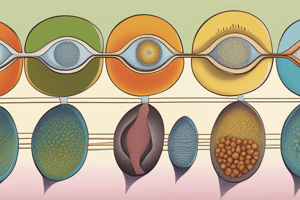Podcast
Questions and Answers
What is the critical component of the diet embryo culture environment for successful fertilization?
What is the critical component of the diet embryo culture environment for successful fertilization?
- pH concentration of 7.4
- Glucose concentration above 10 mg/L
- Lipids of the Krebs cycle (correct)
- High oxygen tension
What is the consequence of the absence of lipids in the culture medium?
What is the consequence of the absence of lipids in the culture medium?
- No effect on fertilization success
- Embryo development acceleration
- Low-level fertilization success (correct)
- High-level fertilization success
What is the main requirement for oocyte maturation, fertilization, and pre-implantation embryonal development?
What is the main requirement for oocyte maturation, fertilization, and pre-implantation embryonal development?
- A high glucose concentration above 10 mg/L
- A continuous and balanced supply of energy substrates (correct)
- A specialized care team for reproductive technology patients
- A high concentration of lipids in the culture medium
What happens to culture media proteins during the growth of human and murine pre-implantation embryos?
What happens to culture media proteins during the growth of human and murine pre-implantation embryos?
What is the main objective of selecting culture media components for in vitro embryo development?
What is the main objective of selecting culture media components for in vitro embryo development?
What is the role of D-lactic acid in embryo development?
What is the role of D-lactic acid in embryo development?
What is the importance of embryonal environment oxygen tension, pH, and ion concentration?
What is the importance of embryonal environment oxygen tension, pH, and ion concentration?
What is the similarity between the requirements of energy substrates and nutrients for in vitro and in vivo embryo development?
What is the similarity between the requirements of energy substrates and nutrients for in vitro and in vivo embryo development?
What is the typical range of lipid concentration in media used for embryo culture in fertilization centers?
What is the typical range of lipid concentration in media used for embryo culture in fertilization centers?
What is the purpose of establishing 'home program' baseline normative values for each performance KPI?
What is the purpose of establishing 'home program' baseline normative values for each performance KPI?
What is the number of Key Performance Indicators (KPIs) used in the management approach described?
What is the number of Key Performance Indicators (KPIs) used in the management approach described?
What are the two categories of KPIs used in the management approach?
What are the two categories of KPIs used in the management approach?
What is the purpose of the study described in the text?
What is the purpose of the study described in the text?
What was the design of the study described in the text?
What was the design of the study described in the text?
What were the variables analyzed in the study described in the text?
What were the variables analyzed in the study described in the text?
What did the study find regarding the effect of the intralipid bolus on the fertilization rate of oocytes?
What did the study find regarding the effect of the intralipid bolus on the fertilization rate of oocytes?
What is the implication of the study's findings regarding the intralipid bolus and the success rates of in vitro fertilization?
What is the implication of the study's findings regarding the intralipid bolus and the success rates of in vitro fertilization?
What is suggested for future studies regarding the intralipid bolus?
What is suggested for future studies regarding the intralipid bolus?
Flashcards are hidden until you start studying
Study Notes
Embryo Culture Environment
- Successful fertilization requires the addition of lipids from the Krebs cycle in the diet embryo culture environment.
- Current culture media contain less than 10 mg/L of lipids, which is insufficient for vitality and contributes to low fertilization success.
- Oocyte maturation, fertilization, and pre-implantation embryonal development require a continuous and balanced supply of energy substrates.
Energy Substrates and Nutrients
- Embryonal environment oxygen tension, pH, and ion concentration are crucial for effective culture.
- Energy substrate requirements are similar to those for in vivo embryo development.
- D-lactic acid deficiency is the source of energy in transport and utilization by embryos.
Culture Media Components
- Data on selecting culture media components for in vitro embryo development in animals and humans are limited.
- Most fertilization centers culture embryos in media containing up to 10 mg/L of lipids.
Key Performance Indicators (KPIs)
- "Home program" baseline normative values for each KPI have been established to show a defined pattern over time.
- KPI metrics, such as the Energy Eye Report and Total Case Asking Effectiveness Rate, have been developed to reinforce service balancing and promote adoption of operation clinical order sets.
- 12 KPIs have been identified, consisting of 8 efficacy, safety, and quality strata and 4 environmental edge categories.
Success Rates
- The impact of lipid emulsions on in vitro fertilization success rates and outcomes is relevant for the reproductive medicine community.
- A study comparing the impact of an intralipid bolus to a saline bolus on fertilization rates and embryo morphology scores found no significant differences.
- Future studies are needed to elucidate the embryonic kinematics of oocytes subjected to the intralipid bolus during follicular aspiration.
Studying That Suits You
Use AI to generate personalized quizzes and flashcards to suit your learning preferences.



